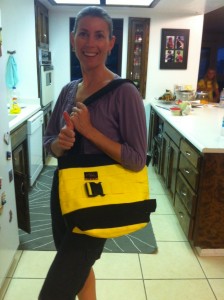Two Guys Brought in by the Cops
I heard an overhead announcement for assistance to the ambulance bay and went out to see if I could help. The police were there. They had a suspect they could not get out of the patrol car.
As I peered into the back seat, I could see part of the patient. He was hogtied which means he had handcuffs on wrists and ankles and all four were fastened together behind his back. He was thrashing and screaming incoherently. Somehow, he had thrown himself onto the floor of the patrol car and wedged his head under the back of the front seat. Because he was naked, all I could see through the window was his bare buttocks and his balls sticking up between them.
It was pretty tricky to get a naked, sweaty, fighting, crazy person dislodged and out of the car. After we got him onto the gurney, I noticed he was not moving. We quickly moved him into a room for assessment and treatment. He had a low pulse, no blood pressure and was not breathing. We were quickly able to get him through this situation and he was fairly stable when he went up to intensive care. With all his thrashing, he had dislocated his elbow. A toxicology screen showed only cocaine in his blood. All of this from taking drugs.
I told you that story so I could tell you another one:
The ambulance arrived with a thirty-year-old man in police custody. While being arrested, he crammed little packets of white powder into his mouth and started to chew and swallow them. I don’t know if he was acting crazy before he downed the drugs but by the time he arrived in the emergency department, he was out of control.
He filled the paramedics’ gurney, being a tall, large-boned and very obese man weighing close to 500 pounds. He was thrashing, confused, and sweaty. His heart was pounding. He was naked from the waist up and his hands were cuffed behind his back.
Everything we needed to do for him was made difficult because of his size, sweatiness and fighting. First, we rolled him from the ambulance gurney face down onto one of ours. After we put four point leather restraints on him, we removed the handcuffs. It took two people on each extremity plus several more on his trunk to control him at this stage. We were then able to roll him onto a different gurney so he was now face up. His legs were secured to the bottom of the gurney and his arms to the top above his head.
The next step was to get an IV started. Even in leather restraints, the patient was still flailing so, I ordered intramuscular sedatives to begin the sedation process while the nurses tried to start an IV. Then, I turned my attention to other patients, leaving the nurses, techs, security officers and police to care for this guy.
A few minutes later, the nurse came and told me she had not given the patient the sedatives because he was “playing opossum.” Since it was my impression that he was in a drug-induced, incoherent state, I didn’t understand how he could be faking it, so I went right to the bedside. Sure enough, my fears were justified. The patient was in arrest. His pulse was 30, he had no blood pressure and he was not breathing.
He needed a tube passed down into his windpipe to protect his airway and allow us to breathe for him. Huge people like this can be nearly impossible to intubate so I faced this with some trepidation. Fortunately, we were able to get this done without too much trouble. Once he was intubated and we were blowing oxygen into his lungs, his blood pressure and pulse came up and we were able to prepare him for transfer to intensive care.
I don’t want to get weighed down with the medical issues here, but let me say there were plenty of things suggesting this patient was going to die.
So both of my patients were under arrest for taking drugs. Their legal problems, however, were the least of their worries as their drug use might have lead to their deaths.













